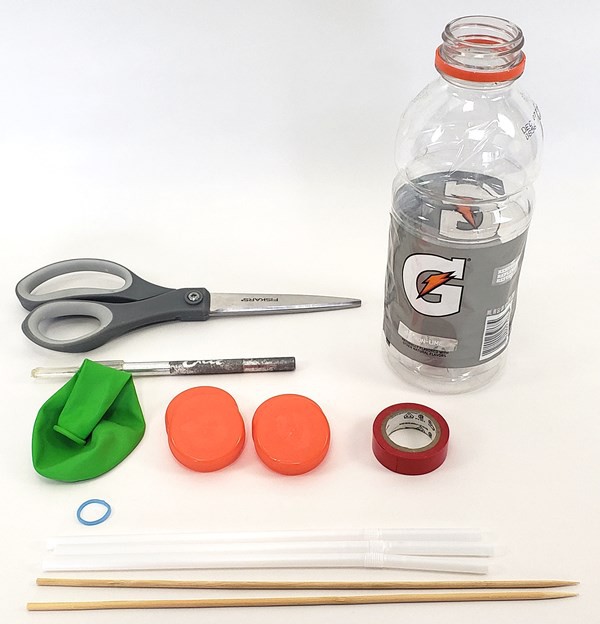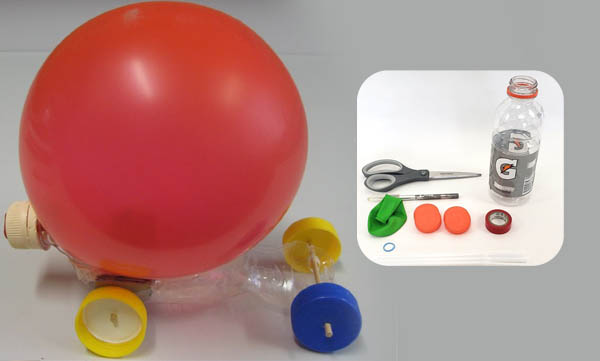Is it possible to power a car with a simple balloon? Science is behind this magic, but it may seem like magic. So let’s explore the balloon car’s movement, how it works, and the principles behind its motion. Let us first learn about it before we start making it. Get ready for an exciting journey into the world of balloon-powered vehicles now!
Understanding the Balloon Car
It is a lightweight vehicle powered by the wind power of an inflated balloon. When the balloon is released, the air rushes out, pushing the car forward with a backward force. It’s a simple but effective way to introduce motion and propulsion.
Science Behind Balloon Cars
Based on Newton’s third law of motion, the balloon vehicle moves based on its opposite reaction to every action. By releasing air from the balloon, it pushes pressure on the surrounding air molecules, producing a force in the opposite direction. Like the smoke from the rocket, this force propels the car forward.
Balloon Cars in Education
Balloon cars are widely used in educational activities to teach basic scientific concepts. These activities provide students with hands-on experience and help them comprehend motion, forces, and energy. To make learning more interactive and enjoyable, balloon car Activity can be included in physics, engineering, or STEM (science, technology, engineering, and math) classes.
The focus of the STEM Lesson
In this activity, kids learn the key concepts of kinetic energy, potential energy, and Newton’s laws of motion.
S – Science
T – Technology
E – Engineering
A – Arts
M – Mathematics
Goals of learning
1: Understand kinetic energy and potential energy and how one energy can be converted to another.
2. Learn about Newton’s third law of motion.
3: Iteratively test and improve design using the engineering design process
4 Learn about the prototype model so that it will help reduce air pollution.
Let’s have some knowledge of the key concepts of this activity:
Kinetic Energy: The kinetic energy of an object is the form of energy possessed by its motion.
The formula for Kinetic Energy is:
K.E. = 1/2 mv^2
Here, m is the mass of an object in kilograms, and v is the velocity in m/s.
Potential Energy: Energy stored in an object due to its position is called Potential Energy.
The formula for Potential Energy is:
P.E. = mg
Here, m is the mass in kilograms, g is the acceleration due to gravity (9.8m/s2 on the surface of the earth), and h is the height in meters (m).
Conservation of Energy: This law states that energy can neither be created nor destroyed. It can only be transformed from one form to another.
Newton’s Third Law of Motion states that for every action, there is an equal and opposite reaction.
Building your own Balloon Car
As many kids’ favorite childhood toy is a car, They spend more time playing with a Car in a whole day. They enjoy it a lot. So, there is an activity for the kids: a Balloon Car. Here, they can learn how to make a Balloon car as well as the key concepts of different forms of energy and the laws of motion. It’s going to be an amazing activity.
Now, moving forward to an activity:
Materials Required:

- Wheels (round objects like CDs and bottle caps, carrom board coins, etc.)
- Axles (wooden skewers, kulfi sticks, pencils, straws, etc.)
- Frame or body (plastic bottles, cardboard boxes, Aluminum foil or toilet paper cardboard rolls, Popsicle or ice-cream sticks, etc.)
- Straws
- Balloons
- Tape
- Scissors
Steps to follow:
- Draw a rough sketch on the paper of your car before going to start.
- Acquire all the necessary types of equipment and start building with us.
- Divide a straw into two halves with scissors. Tape them on one side of the cardboard.
- Cut the wooden skewer and place it into one of the straws. This is going to be your Car’s axle.
- Make a “+” sign in the center of each plastic bottle cap and cut it through with a scissor.
- For making wheels for your car, insert these bottle caps onto the end of the skewer.
- Put your car on a flat surface and push it.
- Points: Before stopping, make sure that the car can move smoothly and rest for a bit. If your car is not working smoothly, then pay attention: Your points: your car’s axle should be parallel, the hole in the bottle cap should be in the center, and the straws should be well taped to the water bottle cap. You can also use glue for better attachment.
- Tape the neck of the balloon to the other straw so that it makes a better connection. You can also use a rubber band or a thread.
- Using tape, attach this straw to the base of your car.
Know Also:
1. How to Make Your Own Harmonica
2. Online Coding Classes for Kids
3. Block Diagram of Kids
So, be ready to test your car and do the same as I mentioned below:
- Blow through the straw to inflate the balloon.
- When the balloon fills with air, immediately use your fingertip to close the hole in the straw so that there is no leakage of air.
- Now, place your car on a flat surface.
- Release your finger and watch the car move until it stops.
- Record how far the car traveled and note it on your worksheet.
Observation and further research
When you test:
- Does the car move in a straight line, or does it move in a curve?
- Does your car move smoothly, or does it stop while moving?
- Does your car move after the bursting of the balloon or suddenly stop?
- How can you improve the design if you find any problems?
Check the flow of energy
- See what adjustments you can make so that your car moves smoothly. What happens when you fill the balloon with more air? How can you increase the potential energy? By doing all this, does it cause any problems?
- You can increase the amount of stored potential energy by increasing the amount of air. It may cause the bursting of a balloon. Some students may think about adding one more balloon so that there is an increment in the potential energy. The back side of the balloon tends to push the air out and move the car in the opposite direction, which states Newton’s third law of motion (For every action, there is an equal and opposite reaction).
- For the fixed amount of potential energy. How can you maximize the distance traveled by your car?
- There are possibilities if we minimize the mass of the car. Making the car’s axle spin much smoother, which causes frictional force, will also reduce the loss of energy.
Problem-Solving:-
While making a car, kids may face some problems. Keep in mind that overcoming these problems is an important step in the engineering design process. Here are some basic issues as well as solutions that you can provide to your students when they run into trouble:
The car does not move at all
- Try making the car lighter.
- Make sure there is a minimum friction force on the axles.
- Stretch the balloon for more inflammation.
The car does not move smoothly
- Make sure the wheels are centered on the axles.
- Spin the wheels through the hands if they are not smoothly moving.
The car drifts off to one side
- Make sure the car’s wheels are aligned and the axles are parallel to each other.
- Make sure the straw is centered on the car’s body.
Air leakage from the balloon
- Wrap the neck of the balloon tightly around the tape or a rubber band.
- Make sure you close the mouth of the balloon tightly with your fingertip so that air does not leak into the surroundings.
In this activity, there is the use of an inflated balloon for energy conservation. How do real cars store energy? How is this energy converted to kinetic energy?
Chemical energy is stored in petrol tanks or electric batteries of real cars, which then power engines to turn the wheels and transform the stored energy into kinetic energy.
Let’s calculate the average speed of your balloon car
The formula for calculating the average speed is:-
Average speed=Total distance covered by the car/Total time taken by the car
S = total distance/Time
Measure the total distance in inches and the time taken in seconds.
So what is your car’s total speed in inches per second?
In Conclusion
The activity of a balloon car brings together science, engineering, and fun in an attractive way. By understanding the principles of motion and utilizing the power of the air, we can create simple yet fascinating vehicles. Whether it’s for educational purposes, entertainment, or competitive racing, balloon cars offer an engaging experience for kids of all ages. So gather your materials, inflate your balloon, and jump on your balloon car adventure.







